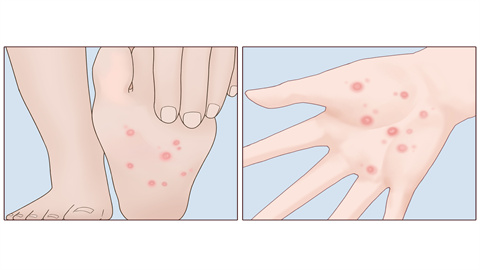What causes pain in the soles of the feet?
Foot sole pain may be caused by prolonged standing or walking, inappropriate footwear, plantar fasciitis, Achilles tendonitis, rheumatoid arthritis, and other factors. Management should be based on the specific situation. It is recommended to visit a hospital promptly and receive treatment as directed by a physician.

1. Prolonged standing or walking: Prolonged standing at work causes continuous pressure and excessive fatigue on soft tissues such as foot muscles and fascia, leading to foot sole pain, often accompanied by soreness and swelling. Arrange rest periods appropriately and avoid standing or walking continuously for long periods. Soaking feet in hot water may help relieve muscle fatigue.
2. Inappropriate footwear: Wearing high heels, overly tight shoes, or shoes with hard soles can alter normal foot pressure distribution, causing excessive compression or friction on the sole, resulting in pain. Pain usually subsides gradually after changing footwear. Choose comfortable, well-fitting shoes with good support to provide a comfortable environment for your feet.
3. Plantar fasciitis: Long-term excessive walking or running can repeatedly strain the plantar fascia, causing wear and tear and aseptic inflammation, which leads to foot sole pain. Symptoms may improve after walking for a while. Under a physician's guidance, patients may use medications such as diclofenac diethylamine gel, ibuprofen sustained-release capsules, and blood circulation-promoting analgesic plasters to alleviate symptoms.
4. Achilles tendonitis: Excessive pressure on the Achilles tendon during exercise or a sudden increase in exercise intensity can cause tendon injury and inflammation. Besides foot sole pain, symptoms include pain and swelling above the heel, with increased pain after activity. It is recommended to use medications such as celecoxib capsules, Yunnan Baiyao plaster, and eperisone hydrochloride tablets as directed by a physician to alleviate discomfort.
5. Rheumatoid arthritis: The body's immune system mistakenly attacks joints and surrounding tissues, affecting foot joints and causing foot sole pain, often accompanied by joint swelling, pain, stiffness—particularly noticeable upon waking in the morning—with symptoms improving after activity. Patients may use medications such as methotrexate tablets, leflunomide tablets, and diclofenac sodium sustained-release tablets as directed by a physician to alleviate symptoms.
In daily life, it is advisable to engage in appropriate foot exercises to strengthen foot muscles and maintain joint flexibility. Regularly check foot health and address any abnormalities promptly.
References:
[1] Wu Honghong, Feng Jiemei, Zheng Xiang, et al. Clinical efficacy of stretching exercises combined with kinesiology taping in treating patients with plantar fasciitis[J]. Reflexology and Rehabilitation Medicine, 2024, 5(12): 58-60+80.
[2] Jia Jun, Chen Huibin. Prevention and treatment of Achilles tendonitis[J]. Kaijuan Youyi - Seeking Medical Advice and Medication, 2024, (08): 50-51.




